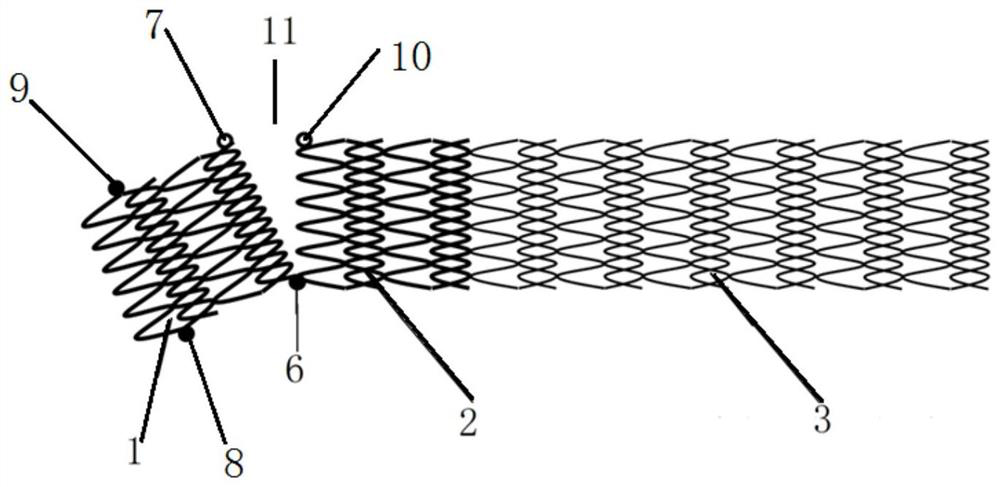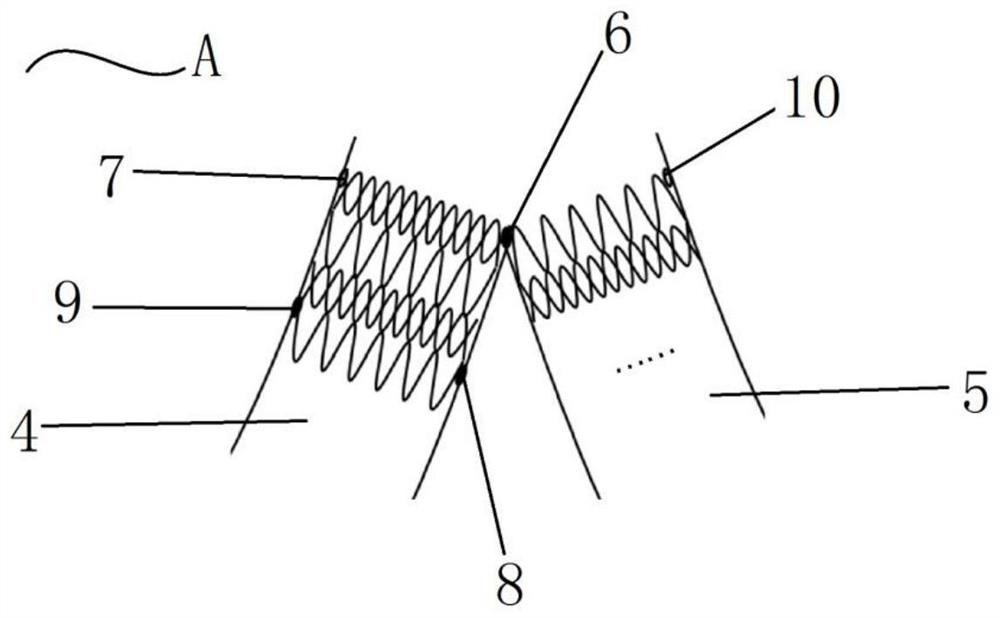Split iliac vein stent and placement method thereof
A technology for iliac veins and veins, applied in the field of split iliac vein stents and their placement, which can solve the problems of difficulty in determining the placement position of the stent, difficult operation, and complicated release process of the stent, and achieve easy determination of the placement position, reduced operation difficulty, Avoid the effects of blood flow disturbance
- Summary
- Abstract
- Description
- Claims
- Application Information
AI Technical Summary
Problems solved by technology
Method used
Image
Examples
Embodiment 1
[0035] The diseased veins are mainly due to iliac vein compression syndrome (Iliacvenous compression syndrome, IVCS for short). IVCS is a disease of lower extremity and pelvic venous return obstruction caused by iliac vein compression and / or the existence of abnormal adhesion structures in the cavity. Usually, the patient's right common iliac artery crosses the left common iliac vein, which is easy to cause external compression of the vein, resulting in iliac vein occlusion or stenosis. This compression and intraluminal changes predispose the patient to left lower extremity deep vein thrombosis. Failure to recognize and treat this abnormality in patients with acute thrombosis can lead to severe vascular sequelae and chronic left leg symptoms. This kind of thromboembolism is difficult to recanalize, and can cause venous return disorders in the lower extremities and pelvis and lower extremity venous hypertension.
[0036] In order to solve the problems in endovascular intervent...
Embodiment 2
[0040] The difference between Embodiment 2 and Embodiment 1 is that a split iliac vein stent includes a distal segment 2 and a proximal segment 3 of the diseased vein that are connected to each other in the diseased vein, and a stent located in another common iliac vein. The segment 1 opposite to the diseased vein, the segment 1 opposite to the diseased vein and the distal segment 2 of the diseased vein can be divided by a stent, and the dividing part is not completely disconnected to form a split opening 11, and the connecting part is formed at the place that is not disconnected, At this time, the connecting part is any arc on the second end of the distal segment of the diseased vein or the segment 1 on the opposite side of the diseased vein, and the arc length of the connecting part is 4-7 mm (or about the distal segment 2 of the diseased vein). 1 / 8-1 / 6 of the perimeter of the end section), and a first developing point 6 is provided at the midpoint of the arc length of the co...
Embodiment 3
[0044] The difference between Embodiment 3 and Embodiment 1 is that a split iliac vein stent in this embodiment includes a distal segment 2 of the diseased vein and a proximal segment 3 of the diseased vein that are connected to each other in the diseased vein, and another iliac vein located in the other iliac vein. The diseased vein contralateral segment 1 of the common vein, the diseased vein is one of the two common iliac veins. In this embodiment, the diameters of the segment 1 on the opposite side of the diseased vein and the segment 2 at the distal end of the diseased vein may be different, and the adjustment method depends on the specific conditions of the patient; for example, the diameter of the segment 1 on the opposite side of the diseased vein is 12 mm and the length is 25 mm , the diameter of the distal segment 2 of the diseased vein is 15mm and the length is 20mm; the diameter of the proximal segment 3 of the diseased vein is 15mm and the length is 30mm. The conn...
PUM
| Property | Measurement | Unit |
|---|---|---|
| Arc length | aaaaa | aaaaa |
| Diameter | aaaaa | aaaaa |
| Length | aaaaa | aaaaa |
Abstract
Description
Claims
Application Information
 Login to View More
Login to View More - R&D
- Intellectual Property
- Life Sciences
- Materials
- Tech Scout
- Unparalleled Data Quality
- Higher Quality Content
- 60% Fewer Hallucinations
Browse by: Latest US Patents, China's latest patents, Technical Efficacy Thesaurus, Application Domain, Technology Topic, Popular Technical Reports.
© 2025 PatSnap. All rights reserved.Legal|Privacy policy|Modern Slavery Act Transparency Statement|Sitemap|About US| Contact US: help@patsnap.com



